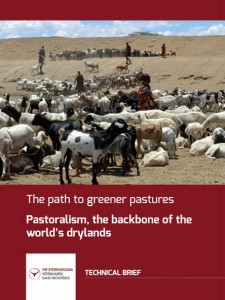Resource information
Pastoralism is a livelihood system based on free-grazing animals that is used by communities in marginal areas. The land may be marginal for various reasons, including poor water supply or soil quality, extreme tem - peratures, steep slopes and remote - ness. Pastoralism enables communi - ties to manage their resources in a sustainable, independent and flexible way. It is marked by rights to com - mon resources, customary values and ecosystem services. Some pastoralists combine livstockkeeping with growing crops for food or forage. Such agropastoralists out - number those who rely on livestock alone for their livelihoods. This brief focuses on pure pastoral - ists who earn the majority of their income from livestock. Such pasto - ralists move their animals from place to place. They may do so from a fixed location (sedentary systems), move regularly between relatively fixed positions (transhumance), or move from place to place following an irregular pattern (nomadism). Estimates of the numbers of pas - toralists worldwide range from 22 million to more than 200 million, de - pending on the definition used and the age and quality of the data. Many of them are in sub-Saharan Africa, where pastoralism is a major land use in an area stretching from Senegal in the west, across the Sahel to Somalia, and southwards through East Africa to Botswana and Namibia. In many countries in this arc, pastoralism is a major employer and source of animal protein. Pastoralism is also important in the drylands of Central and South Asia, the Altiplano of South America,the plateau of Tibet, and the tundra of northern Europe and Asia.


